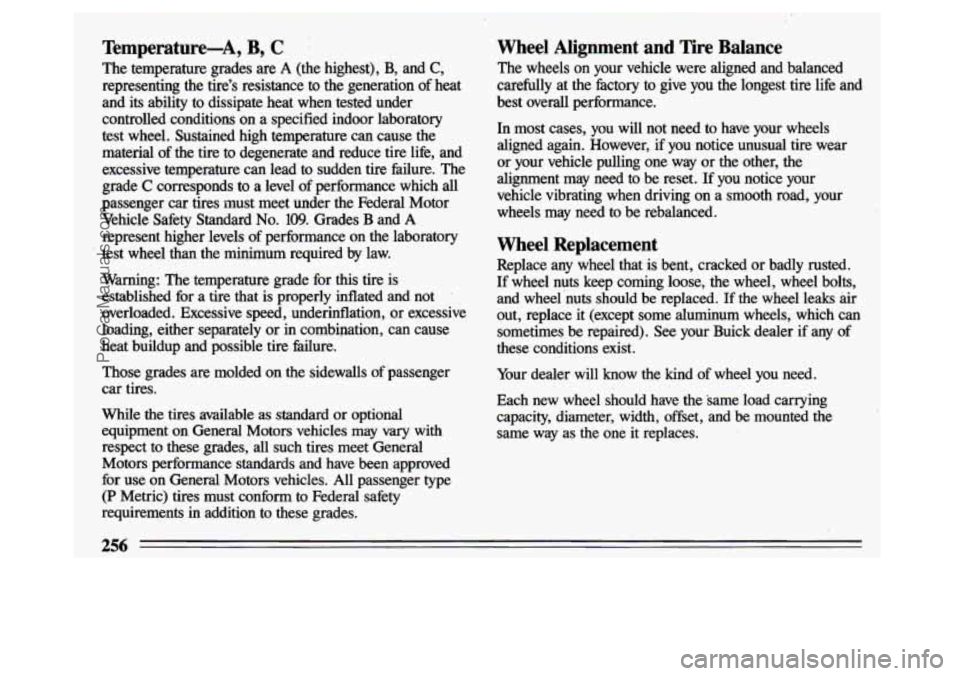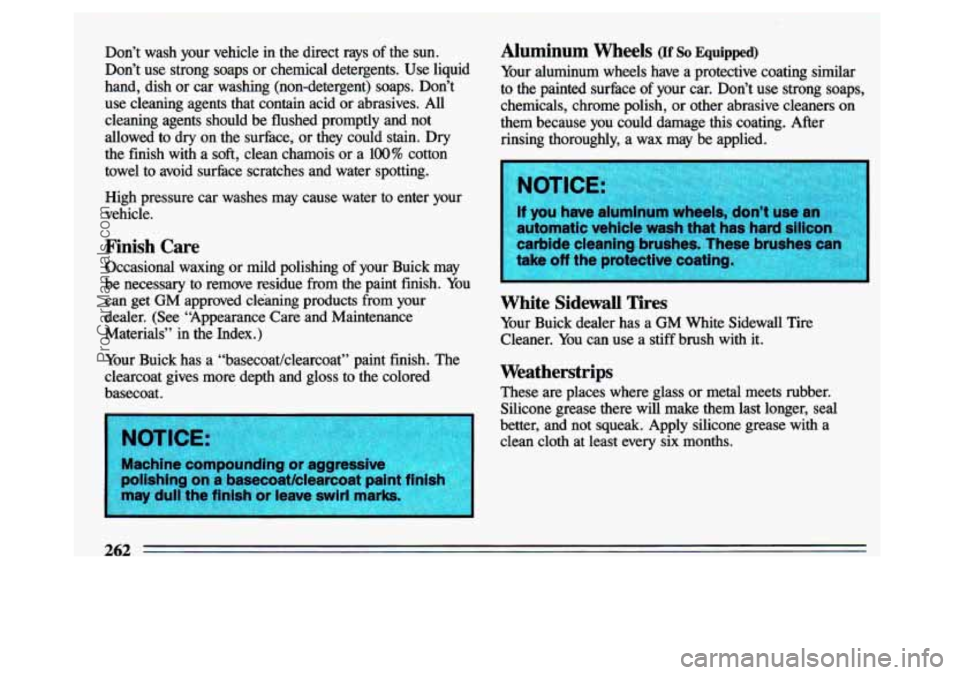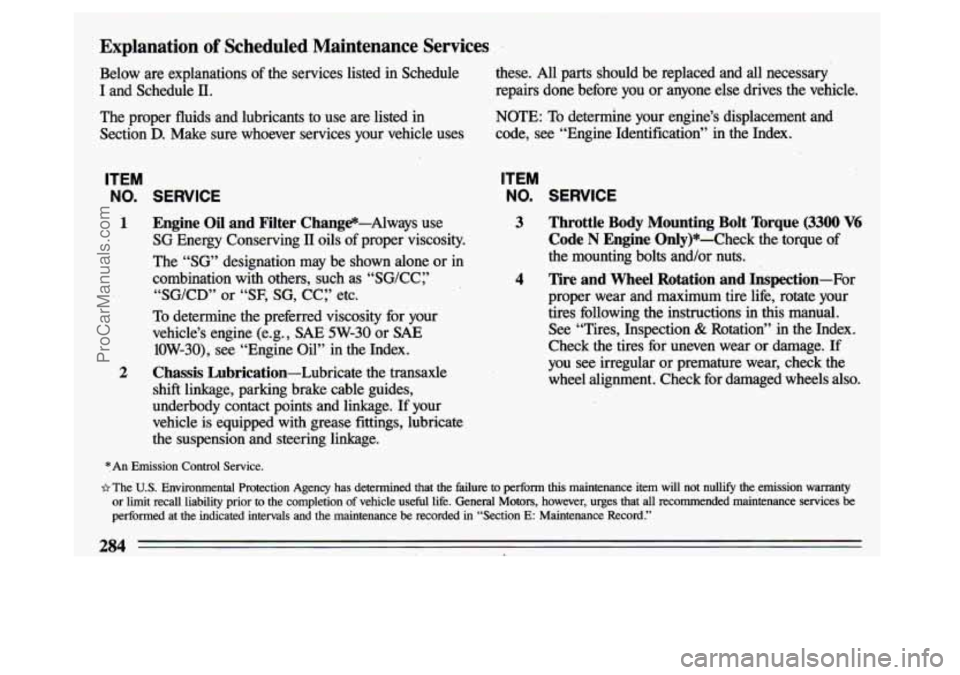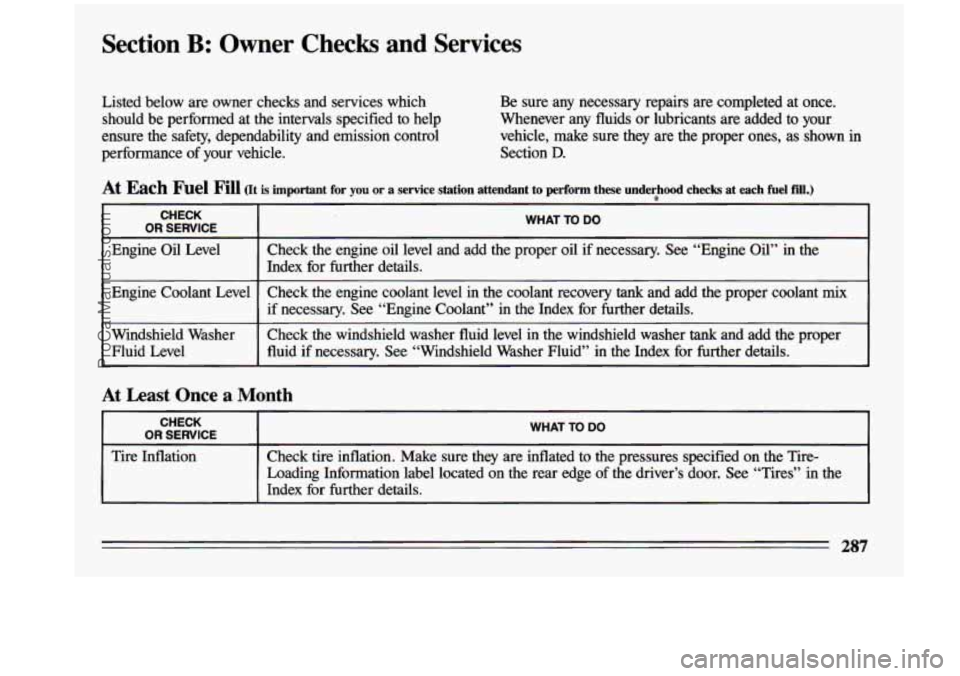1993 BUICK CENTURY tires
[x] Cancel search: tiresPage 256 of 324

i
When It's Time for New Tires
One way to tell when it's
time for new
tires is to
check the treadwear
indicators, which will
appear when your tires have
only
2/32 inch (1.6 mm) or
less of tread remaining.
You need a new tire if
You can see the indicators at
three places around the tire.
You can see cord or
fabric showing through
the tire's rubber.
The tread or sidewall is cracked, cut or snagged deep
The tire has a bump, bulge or split.
The tire has a puncture, cut, or other damage that can't
be repaired well because of the size or location
of the
damage. enough to show cord
or fabric.
Buying New Tires
To find out what kind and size of tires you need, look at
the Tire-Loading Information label.
The tires installed on your vehicle when it was new .had a
Tire Performance Criteria Specification (TPC Spec)
number on each tire's sidewall. When you get new tires,
get ones with that same TPC
Spec number. That way,
your vehicle will continue to have tires that are designed'
to give proper endurance, handling, speed rating,
traction, ride and other things during normal service on
your vehicle.
If your tires have an all-season tread design,
the TPC number will be followed by a
"MS" (for mud
and snow).
If you ever replace your tires with those not having a
TPC Spec number, make sure they are the same
size,
load range, speed rating and construction type (bias,
bias-belted
or radial) as your original tires.
254
ProCarManuals.com
Page 257 of 324

*
I A CAUTION:
Mlxing tires could cause you to lose control
while driving.
If you mlx tires of different sizes
or types (radial and bias-belted tires) the
vehlcle may not handle
properly, and you
could have
a crash. Be sure to use the same
size and type
tires on all four wheels. It’s all
right to drive wlth your compact spare,
though.
It was developed far use on your
vehicle.
I
Uniform Tire Quality Grading
The following information relates to the system developed
by the United States National Highway Traffic Safety
Administration which grades tires by treadwear, traction
and temperature performance. (This applies only to
vehicles
sold in the United States.)
Treadwear
The treadwear grade is a comparative rating based on the
wear rate of the tire when
tested under controlled
conditions on a specified government test course. For
example, a tire graded
150 would wear one and a half
(1%) times as well on the government course
as a tire
graded
100. The relative performance of tires depends
upon the actual conditions of their use, however, and may
depart significantly from the norm due to variations
in
driving habits, service practices and differences in road
characteristics and climate.
Traction-A, B, C
The traction grades, from highest to lowest are: A, B,
and C. They represent the tire’s ability to stop on wet
pavement as measured under controlled conditions on specified government test surfaces of asphalt and
concrete.
A tire marked C may have poor traction
performance.
Warning: The traction grade assigned to this tire is based
on braking (straight-ahead) traction tests and does not
include cornering (turning) traction.
255
ProCarManuals.com
Page 258 of 324

Temperature-A, B, C
The temperature grades are A (the highest), B, and C,
representing the tire's resistance to the generation of heat
and
its ability to dissipate heat when tested under
controlled conditions on a specified indoor laboratory
test wheel. Sustained high temperature can cause the material'of the tire to degenerate and reduce tire life, and
excessive temperature can lead to sudden tire failure. The
grade
C corresponds to a level of performance which all
passenger car tires must meet under the Federal Motor
Vehicle Safety Standard
No. 109. Grades B and A
represent higher levels of performance on the laboratory
test wheel than the minimum required by law.
Warning: The temperature grade for
this tire is
established for a tire that is properly inflated and
not
overloaded. Excessive speed, underinflation, or excessive
loading, either separately or in combination, can cause
heat buildup and possible tire failure.
Those grades are molded on the sidewalls of'passenger
car tires.
While the tires available as standard or optional
equipment on General Motors vehicIes may vary with
respect to these grades, all such tires meet General
Motors performance standards and have been approved
for use
on General Motors vehicles. All passenger type
(P Metric) tires must conform to Federal safety
requirements in addition to these grades.
Wheel Alignment and Tire Balance
The wheels on your vehicle were aligned and balanced
carefully at the, factory to give you the longest tire life and
best overall performance.
In most cases, you will not need to have your wheels
aligned again. However, if you-notice unusual tire wear
or your vehicle pulling one way or the other, the
alignment may need
to be reset. If you notice your
vehicle vibrating when driving on a
smooth road, your
wheels may need to be rebalanced.
Wheel Replacement
Replace any wheel that is bent, cracked or badly rusted.
If wheel nuts keep coming loose, the wheel, wheel bolts,
and wheel'nuts should be replaced. If the wheel leaks air
out, replace it (except some aluminum wheels, which can sometimes be repaired). See your Buick dealer
if any of
these conditions exist.
Your dealer will know the kind
of wheel you need.
Each new wheel should have the same load carrying
capacity, diameter, width, offset, and be mounted the same way as the one
it replaces.
256
ProCarManuals.com
Page 259 of 324

If you need to replace any of your wheels., wheel bolts, or
wheel nuts, replace them only with new
GM original
equipment parts. This way, you will be sure
you have the
right wheel, wheel bolts, and wheel nuts for your Buick
model.
A CAUTION:
Using the wrong replacement wheels, wheel
bolts, or wheel nuts on your vehicle can be
dangerous.
It could affecf the braking and
handling of your vehicle, make your tires lose
air and make you lose control. You could have
a collision in which you or others could be
injured. Always use the correct wheel, wheel
bolts,
and wheel nuts for replacement.
Used Replacement Wheels
Tire Chains
257
ProCarManuals.com
Page 264 of 324

Don’t wash your vehicle in the direct rays of the sun.
Don’t use strong soaps or chemical detergents. Use liquid
hand, dish or car washing (non-detergent) soaps. Don’t
use cleaning agents that contain acid or abrasives. All
cleaning agents should be flushed promptly and not
allowed to dry on the surface, or they could stain. Dry
the finish with a
soft, clean chamois or a 100% cotton
towel to avoid surfhce scratches and water spotting.
High pressure car washes may cause water to enter your
vehicle.
Finish Care
Occasional waxing or mild polishing of your Buick may
be necessary to remove residue from the paint finish. You
can get
GM approved cleaning products from your
dealer. (See “Appearance Care and Maintenance Materials” in the Index.)
Your Buick has a “basecoat/clearcoat” paint finish. The
clearcoat gives more depth and gloss to the colored
basecoat.
Aluminum Wheels (If SO Equipped)
Your aluminum wheels have a protective coating similar
to the painted surface of your car. Don’t use strong soaps,
chemicals, chrome polish, or other abrasive cleaners on
them because you could damage this coating. After
rinsing thoroughly, a wax may be applied.
White Sidewall Tires
Your Buick dealer has a GM White Sidewall Tire
Cleaner. You can use a stiff brush with it.
Weatherstrips
These are places where glass or metal meets rubber.
Silicone grease there will make them last longer, seal
better, and not squeak. Apply silicone grease with a
clean cloth at least every six months.
262
ProCarManuals.com
Page 266 of 324

Appearance Care and Maintenance Materials
You can get these from your Buick dealer .
DESCRIPTION USAGE PAFlT NUMBER
Magic Mirror Creme Wax ............. Exterior cleaner and polish ......... 12345343
Spray-A-Squeak
..................... Weatherstrips ..................... 1052277
Silicone Grease
..................... Stops squeaks ..................... 1052863
Tar and Road
Oil Remover ............ Also removes old waxes, polishes .... 1050172
Chrome Cleaner and Polish
........... Removes rust and corrosion .......... 1050173
White Sidewall Tire Cleaner
.......... Cleans white and black tires ......... 1050174
VinyULeather Cleaner
............... Spot and stain removal .............. 1050214
Fabric Cleaner
...................... Spot and stain removal .............. 1050244
Multi-Purpose Powdered Cleaner
........ Cleans vinyl and cloth, also. tires ...... 1050429
and
mats
latches
Glass Cleaner
....................... Also spot cleans vinyls ............. 1050427
Lubriplate
(Wh~te Grease) ............ For hood. trunk, door hinges and ..... 1052349
Preservatone
.................. .... Vinyl Top Dressing ................ 1051055
Washer Solvent
..................... Windshield-washing system .......... 1051515
Spot Lifter
........................ For cloth ........................ 105l398*
Wash-Wax (concentrate)
.............. Exterior Wash ..................... 1052870
SIZE
16 oz . (0.473L)
12 oz . (0.354L)
1
oz . (0.02Skg)
16 oz . (0.473L)
16
oz . (0.473L)
16
oz . (0.473L)
32
oz . (0.946L)
16
oz . (0.473L)
23
oz . (0.680L)
6 lb
. (2.72kg)
12 oz . (0.340kg)
16
oz . (0.473L)
8 oz . (0.237L)
32
oz . (0.946L)
16
oz . (0.473L)
* Not recommended .for pigskin suede leather .
See your General Motors dealers for these products .
See your Maintenance Schedule for other products .
264
I
ProCarManuals.com
Page 286 of 324

Explanation of Scheduled Maintenance Services
Below are explanations of the services listed in Schedule
I and Schedule II.
The proper fluids and lubricants to use are listed in
Section
D. Make sure whoever services your vehicle uses
ITEM
NO. SERVICE
1 Engine Oil and Filter Change-Always use
SG Energy Conserving 11 oils of proper viscosity.
The “SG” designation may be shown alone or in
combination with others, such as ‘‘SG/CC:’
“SG/CD” or “SF, SG, CC:’ etc.
To determine the preferred viscosity for your
vehicle’s engine (e.g., SAE
5W-30 or SAE
10W-30), see “Engine Oil” in the Index.
2 Chassis Lubrication-Lubricate the transaxle
shift linkage, parking brake cable guides,
underbody contact points and linkage. If your
vehicle is equipped with grease fittings, lubricate
the suspension and steering linkage. these. All parts should be replaced and all necessary
repairs done before you or anyone else drives the vehicle.
NOTE: To determine your engine’s displacement and
code, see “Engine Identification” in the Index.
ITEM
NO. SERVICE
3 Throttle Body Mounting Bolt Torque (3300 V6
Code N Engine Only)*-Check the,torque of
the mounting bolts and/or nuts.
4 Tire and Wheel Rotation and Inspection-For
proper wear and maximum tire life, rotate your
tires following the instructions
in this manual.
See “Tires, Inspection & Rotation” in the Index.
Check the tires for uneven wear or damage. If
you see irregular or premature wear, check the
wheel alignment. Check for damaged wheels also.’
*An Emission Control Service.
~2 The U.S. Environmental Protection Agency has determined that the failure to perform this maintenance item will not nullify the.emission warranty
or limit recall liability prior
to the completion of vehicle useful life. General Motors, however, urges that all recommended maintenance services be
performed at the indicated intervals and the maintenance be recorded in “Section E: Maintenance Record.”
284
ProCarManuals.com
Page 289 of 324

Section B: Owner Checks and Services
Listed below are owner checks and services which should be performed at the intervals specified to help
ensure the safety, dependability and emission control
performance of your vehicle. Be
sure any necessary repairs are completed at once.
Whenever any fluids or lubricants are added to your
vehicle, make sure they are the proper ones, as shown in
Section
D.
At Each Fuel Fill (It is important for you or a service station attendant to perform these undechd checks at each fuel fill.)
CHECK
I OR SERVICE I WHAT TO DO
Engine Oil Level
Check the engine oil level and add the proper oil if necessar\
y. See “Engine Oil” in the
Index for further details.
Engine Coolant Level Check the engine coolant level in the coolant recovery tank and add \
the proper coolant mix
I if necessary. See “Engine Coolant” in the Index for furth\
er details. I
Windshield Washer Check the windshield washer fluid level in th\
e windshield washer tank and add the proper
Fluid Level
I fluid if necessary. See “Windshield Washer Fluid” in the \
Index for further details. I
At Least Once a Month
CHECK
I OR SERVICE I WHAT TO DO
Tire Inflation Check tire inflation. Make sure they are inflate\
d to the pressures specified on the Tire-
Loading Information label located on the rear edge of the driv\
er’s door. See “Tires”
in the
Index
for further details.
287
ProCarManuals.com